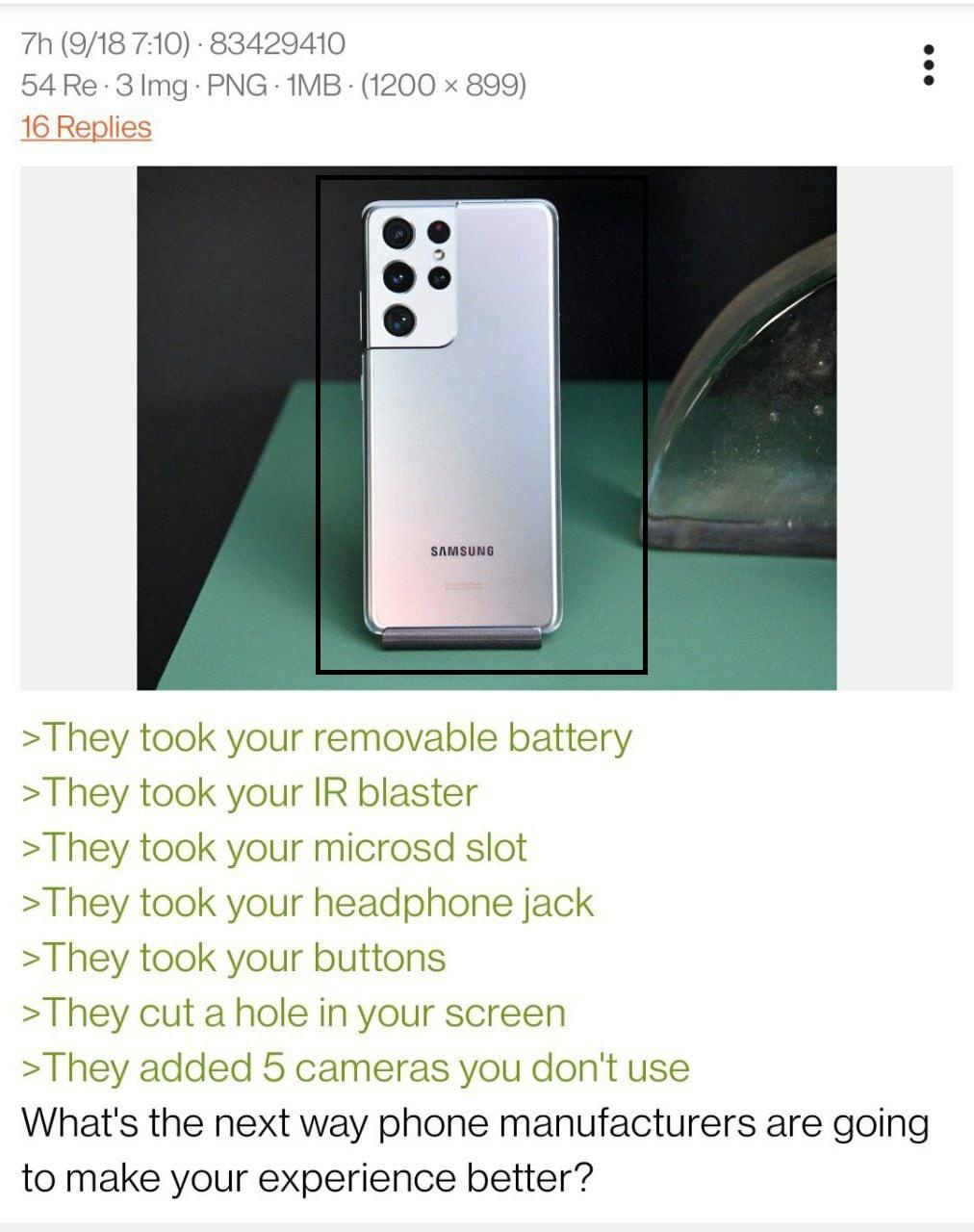this post was submitted on 14 Jan 2024
1437 points (97.4% liked)
Greentext
5208 readers
1925 users here now
This is a place to share greentexts and witness the confounding life of Anon. If you're new to the Greentext community, think of it as a sort of zoo with Anon as the main attraction.
Be warned:
- Anon is often crazy.
- Anon is often depressed.
- Anon frequently shares thoughts that are immature, offensive, or incomprehensible.
If you find yourself getting angry (or god forbid, agreeing) with something Anon has said, you might be doing it wrong.
founded 1 year ago
MODERATORS
you are viewing a single comment's thread
view the rest of the comments
view the rest of the comments

At least removable batteries will be mandatory in EU by 2027.
There are different categories of removable.
With my old Note, I had an extra battery that came with case/charger combination. If my battery on my phone died, I could swap the battery in 10 seconds.
It states that any battery should be removable and replaceable by the user. So this slap on tactic will only work if your device has no internal battery.
I also noticed this is for all batteries. Not just phones, but also cars etc.
EDIT: As any EU law there is a lot of nuance and exceptions. I dig a little further and found the following:
So what is LMT?
I couldn't find any concrete wording for "easily removed and replaceable". But I sure hope it means no more glue for the portable batteries.
Source: https://www.intertek.com/blog/2023/08-17-battery-regulation/
"Replaceable by user" has a lot of wiggle room. It could still be a 20-minute process that risks damaging other parts and requires specialized tools.
If phones are to keep their water resistance, they almost certainly won't be tooless, and will involve swapping out gaskets. It'll be something you can do to replace a failed battery, not a quick swap because you went camping for the weekend and threw an extra battery in the bag since there are no outlets.
Could you read and understand the information behind the link before replying with nonsense?
FYI: there were waterproof phones before replaceable batteries disappeared. Also the Fairphone for example IPS rated for resistant, so not perfect, but it's possible.
"User replaceable" just means that they have to make it possible, not easy.
Usually legislation is intentionally vague like that, ultimately courts will decide what that really means in practice.
It will end up being just reasonable. Any person can have a reasonable expectation that they will be able to replace the battery with a reasonable amount of time and effort, with readily available tools, with a reasonable amount of guidance.
If you were a judge would you say that it's reasonable to expect people to be able to replace soldered components on their phones?
None of that addresses his point that "removable by the user" is not clearly defined. I didn't see any definition for it in the link you posted.
Yeah, Apples replacement kit requires like 11k deposit and comes in two 75 pound pelican cases.
What do you mean only if it has no internal battery? This will make it so they can't fuse a battery in place and call it internal. It has to be removable.
That is what I meant?
That it is nice the op has a battery-case for their phone, but that it will not fly under the new law unless the phone has no internal battery.
You mean an internal battery in addition to a main removable one? Sorry if I'm being dense.
I agree. I used to carry a spare at all times as well. So nice to be able to swap as soon as you get close to empty. I'm hoping we'll get back there eventually.
No. This law keeps being misquoted, and people are going to be disappointed if they go into 2027 thinking we'll be able to pop out batteries like the good ol' days.
It does not necessitate battery removal like that. Only that it not be too difficult to change out for a repair (i.e. stuff like gluing it in place with a strong glue, or necessitating removing the display before the battery). That's still a good change, I'd be happy if it were something like removing 4 screws then unplugging, but it's not the same as what everybody makes out.
It also doesn't apply at all for batteries over a certain capacity, or so long as the battery retains 63% capacity or more (presumably this means throughout the warranty period, but I'm unable to find a timeframe for which this standard gets applied) from 2027, or 73% from 2030.
There's also a 2 year grace period after the law comes into effect where it won't really be applied.
I know. While I didn't read the full legal text, tech news sources are saying it needs to be replaceable by an independent third party or the customer themselves with regularly available tools. I'd love to have easy slide in/out batteries, but I know this is not that.
I didn't know about this clause. That's too bad. :(